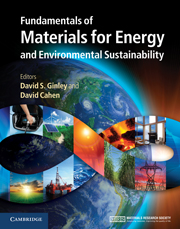Book contents
- Frontmatter
- Contents
- Contributors
- Preface
- Acknowledgments
- Part 1 Energy and the environment: the global landscape
- Part 2 Nonrenewable energy sources
- 9 Petroleum and natural gas
- 10 Advancing coal conversion technologies: materials challenges
- 11 Oil shale and tar sands
- 12 Unconventional energy sources: gas hydrates
- 13 Nuclear energy: current and future schemes
- 14 Nuclear non-proliferation
- 15 Nuclear-waste management and disposal
- 16 Material requirements for controlled nuclear fusion
- Part 3 Renewable energy sources
- Part 4 Transportation
- Part 5 Energy efficiency
- Part 6 Energy storage, high-penetration renewables, and grid stabilization
- Summary
- Appendix A Thermodynamics
- Appendix B Electrochemistry
- Appendix C Units
- Index
- References
9 - Petroleum and natural gas
from Part 2 - Nonrenewable energy sources
Published online by Cambridge University Press: 05 June 2012
- Frontmatter
- Contents
- Contributors
- Preface
- Acknowledgments
- Part 1 Energy and the environment: the global landscape
- Part 2 Nonrenewable energy sources
- 9 Petroleum and natural gas
- 10 Advancing coal conversion technologies: materials challenges
- 11 Oil shale and tar sands
- 12 Unconventional energy sources: gas hydrates
- 13 Nuclear energy: current and future schemes
- 14 Nuclear non-proliferation
- 15 Nuclear-waste management and disposal
- 16 Material requirements for controlled nuclear fusion
- Part 3 Renewable energy sources
- Part 4 Transportation
- Part 5 Energy efficiency
- Part 6 Energy storage, high-penetration renewables, and grid stabilization
- Summary
- Appendix A Thermodynamics
- Appendix B Electrochemistry
- Appendix C Units
- Index
- References
Summary
Focus
Petroleum and natural gas have been the mainstay of energy production in developed countries. Global energy demand will continue to increase with “globalization.” Oil and natural gas will continue to supply a majority of our energy in the near future and production will be from natural sources of petroleum, coal, and natural gas. For example, Energy Independence has reported that the USA has an estimated 260 billion tons of recoverable coal, equivalent to three or four times as much energy in coal as Saudi Arabia has in oil [1]. The needed increase requires the exploitation of conventional and unconventional reservoirs of oil and gas in an “environmentally friendly” manner. This necessitates advances in materials in the form of better catalysts to produce clean fuels and advanced materials for high-pressure, high-temperature, and high-stress processes.
Synopsis
The National Petroleum Council (NPC) in the USA recently published a report entitled Facing the Hard Truths about Energy that evaluates oil and gas supply and demand in the early part of the twenty-first century [2]. The report concluded that the total global demand for energy will grow by 50%–60% by 2030 due to the increase in world population and higher average standards of living in some developing countries. Clearly, for the next few decades, oil, gas, and coal will continue to be the primary energy sources. The energy industry will have to continue increasing the supply of hydrocarbon fuels to meet the global energy demand. There are ample hydrocarbon resources to meet the demand well into the twenty-first century. The volumes of oil and natural gas located in unconventional reservoirs are much larger than the conventional reservoirs currently used for what has been produced thus far.
- Type
- Chapter
- Information
- Publisher: Cambridge University PressPrint publication year: 2011
References
- 1
- Cited by

